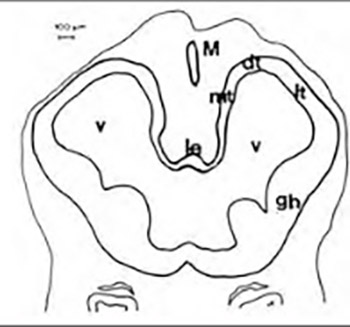Morphogenesis of the rat forebrain
DOI:
https://doi.org/10.17305/bjbms.2004.3467Keywords:
morphogenesis, rat forebrainAbstract
Developmental process that leads to final forebrain shaping is a result of complex histogenetic and morphogenetic events. Comprehensions about brain development are based on observations carried out on onthogenetic successive stages. Microscopic analysis of brain together with analysis of serial sections gives information about shape the of some forebrain parts and basic relations between them. The aim of this study was to analyse morphogenesis in the earliest stages of rat's forebrain development.
MATERIAL AND METHODS:
Rat brains used in this study were obtained from Fisher inbred rats with accurately timed pregnancies. The investigation was carried out on serial frontal sections of rat embryonic heads from the 12th (E12) to the 16th (E16) day of gestation. Gestation was considered to have begun early in the morning when sperm was found in the vaginal smear. Histological paraffin and plastic sections were systematically inspected with regard to morphogenetic changes of the forebrain parts telencephalon and diencephalon.
RESULTS:
E12: neural tube is completely closed in its cranial part. Rostral part of forebrain shows telencephalons vesicles origins as slightly paired enlargements of neuroepithelial wall. Between telencephalic vesicles origin and in direction to caudal there is an origin of diencephalon. E13: rostral part of forebrain shows well expressed and divided areas of telencephalons vesicles as basal, basolateral, dorsal and medial telencephalon. Central area between paired vesicles is a telencephalon impar. In diencephalon optic vesicles appeared. Epithalamus, thalamus and hypothalamus origins are slight enlargements of its neuroepithelial wall. E14: telencephalic vesicles spread above telencephalon impar into rostral direction and above diencephalon in rostrodorsal direction. Their basolateral parts of are very thickened and become folded. Sulcus telodiencephalicus appears. E15: the main event is the appearance of the origins of plexus choroideus in the area of telencephalon impar as fingerlike processes. E16: all forebrain parts, especially telencephalic vesicles-origin of brain hemispheres and processes of plexus choroideus, are progressively growing and shaping.
CONCLUSIONS:
Our morphologic analysis describes significant morphogenetic changes in the forebrain shape. The forebrain changes from a relatively simple tubular structure with thin walls surrounding a large ventricular system to a thick-walled brain with a highly convoluted but reduced ventricular system.
Citations
Downloads

Downloads
Published
How to Cite
Accepted 2018-04-06
Published 2004-02-20









